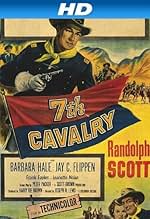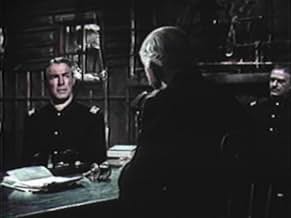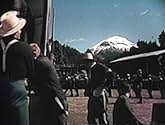PUNTUACIÓN EN IMDb
5,8/10
1,4 mil
TU PUNTUACIÓN
Añade un argumento en tu idiomaAn officer accused of cowardice volunteers to bring back General Custers's body after Little Big Horn.An officer accused of cowardice volunteers to bring back General Custers's body after Little Big Horn.An officer accused of cowardice volunteers to bring back General Custers's body after Little Big Horn.
Bill Clark
- Soldier With Kellogg
- (sin acreditar)
Charles Horvath
- Knife-Wielding Indian
- (sin acreditar)
William Leslie
- Lt. Murray
- (sin acreditar)
Harold Miller
- Officer at Inquiry
- (sin acreditar)
Argumento
¿Sabías que...?
- CuriosidadesThe surname 'Kellogg' is used for two characters in the film - the colonel and his daughter Martha. It is also the surname of Mark Kellogg, a newspaper reporter who rode with Custer's troops. He was killed at the Battle of the Little Big Horn.
- PifiasAs Corporal Morrison (Harry Carey Jr.) saddles "Dandy", Lt. Col. Custer's second mount, he puts on an English saddle. US Calvary adopted McClellan saddles which remained in service through World War II. This was the wrong saddle for the movie.
- Citas
[first lines]
Capt. Tom Benson: We'll be able to see the fort from the top of the next rise.
[Tom and Martha ride a little farther]
Capt. Tom Benson: There she is - Fort Lincoln, the base of the finest cavalry regiment in the country - and our home.
- Créditos adicionalesOpening credits: Capt. Benson was returning with his future bride, to his post commanded by the gallant Indian fighter Colonel Custer, who had prepared the famous 7th for all out war with the Sioux.
Reseña destacada
A very satisfying western with Scott as a cavalry officer who returns with his fiancée to his detail to find the fort apparently deserted. There's a nice 360-degree shot of the surroundings as Scott surveys the area, then he's interrupted by the voice of a woman (Jeannette Nolan) whose claims that Scott is alive at the expense of her husband who took his place in the infamous battle of the Little Big Horn.
The story deals with the aftermath, not the battle itself, so anyone looking for an epic confrontation in the manner of THEY DIED WITH THEIR BOOTS ON or even one as budget conscious as that in THE GREAT SIOUX MASSACRE is bound to be disappointed. However, there are rewards to be found - one of them Scott's performance. Even at about age 57 or 58, he still looks splendid in a uniform, and while of course doubles are used in two fight scenes, there's enough of him present to debunk the rumor that he was not exactly at his best in such scenes. In the inquest scene alone he delivers more dialog than he probably had in his previous three films, and does so convincingly. This scene also features testimony by Captain Benteen and Major Reno, two survivors of the battle who are treated sympathetically.
Director Joseph H. Lewis claimed to not be inspired with the assignment of this film, but he does not let it show. Granted the story may seem slow to start by those who are expecting more than exposition, but here is where we find the first filmic questioning of the judgment of General Custer in what was one of the great military debacles in history. The chase scene in which one comment claims the same stump was passed twice is actually passed three times, once by the Indian brave being chased, next by Scott and then last by two riders following Scott. The scenery is not that of the Montana plains, but it subs nicely. If John Ford can shoot MY DARLING CLEMENTINE in Monument Valley, then Lewis should be allowed his own dramatic license.
The cast is filled with familiar faces, including Michael Pate, Leo Gordon and Harry Carey, Jr., all more recognizable as being part of the Duke's stock company. Add to that Frank Faylen and Jay C. Flippen, as well as Barbara Hale who did deserve more screen time. Just about all are questioning Scott's decision to voluntarily take a patrol to retrieve the dead from the massacre site, but Scott's reasons are to redeem himself for various reasons to each.
A nice touch is in the scene where Scott questions a Sioux "peacemaker" who claims that the bodies, cavalry included, are all now part of sacred ground and instill in each brave the courage and honor of the tribe that conquered them. Scott asks if this is not just mere "superstition" whereas the brave turns the term back at Scott relative to his own spiritual beliefs. This was heady stuff in the mid-fifties when religious epics such as THE ROBE and THE TEN COMMANDMENTS were treated with such reverence. In turn, the appearance of Custer's riderless horse, further takes up the issue of superstition although it would spoil the outcome to reveal just how it does. 7TH CAVALRY is an interesting piece of historical fiction that can take its place among the better non-Boetticher westerns for Scott.
The story deals with the aftermath, not the battle itself, so anyone looking for an epic confrontation in the manner of THEY DIED WITH THEIR BOOTS ON or even one as budget conscious as that in THE GREAT SIOUX MASSACRE is bound to be disappointed. However, there are rewards to be found - one of them Scott's performance. Even at about age 57 or 58, he still looks splendid in a uniform, and while of course doubles are used in two fight scenes, there's enough of him present to debunk the rumor that he was not exactly at his best in such scenes. In the inquest scene alone he delivers more dialog than he probably had in his previous three films, and does so convincingly. This scene also features testimony by Captain Benteen and Major Reno, two survivors of the battle who are treated sympathetically.
Director Joseph H. Lewis claimed to not be inspired with the assignment of this film, but he does not let it show. Granted the story may seem slow to start by those who are expecting more than exposition, but here is where we find the first filmic questioning of the judgment of General Custer in what was one of the great military debacles in history. The chase scene in which one comment claims the same stump was passed twice is actually passed three times, once by the Indian brave being chased, next by Scott and then last by two riders following Scott. The scenery is not that of the Montana plains, but it subs nicely. If John Ford can shoot MY DARLING CLEMENTINE in Monument Valley, then Lewis should be allowed his own dramatic license.
The cast is filled with familiar faces, including Michael Pate, Leo Gordon and Harry Carey, Jr., all more recognizable as being part of the Duke's stock company. Add to that Frank Faylen and Jay C. Flippen, as well as Barbara Hale who did deserve more screen time. Just about all are questioning Scott's decision to voluntarily take a patrol to retrieve the dead from the massacre site, but Scott's reasons are to redeem himself for various reasons to each.
A nice touch is in the scene where Scott questions a Sioux "peacemaker" who claims that the bodies, cavalry included, are all now part of sacred ground and instill in each brave the courage and honor of the tribe that conquered them. Scott asks if this is not just mere "superstition" whereas the brave turns the term back at Scott relative to his own spiritual beliefs. This was heady stuff in the mid-fifties when religious epics such as THE ROBE and THE TEN COMMANDMENTS were treated with such reverence. In turn, the appearance of Custer's riderless horse, further takes up the issue of superstition although it would spoil the outcome to reveal just how it does. 7TH CAVALRY is an interesting piece of historical fiction that can take its place among the better non-Boetticher westerns for Scott.
- clore_2
- 25 nov 2006
- Enlace permanente
Selecciones populares
Inicia sesión para calificar y añadir a tu lista para recibir recomendaciones personalizadas
- How long is 7th Cavalry?Con tecnología de Alexa
Detalles
- Fecha de lanzamiento
- País de origen
- Idioma
- Títulos en diferentes países
- El setè de cavalleria
- Localizaciones del rodaje
- Empresas productoras
- Ver más compañías en los créditos en IMDbPro
- Duración1 hora 15 minutos
- Relación de aspecto
- 1.85 : 1
Contribuir a esta página
Sugerir un cambio o añadir el contenido que falta

Principal laguna de datos
By what name was El séptimo de caballería (1956) officially released in India in English?
Responde




































